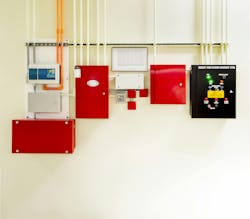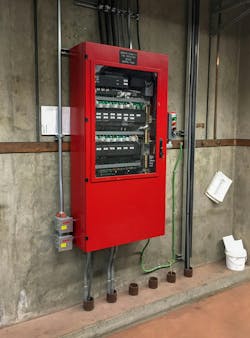This article originally appeared in the May 2024 issue of Security Business magazine. Don’t forget to mention Security Business magazine on LinkedIn and @SecBusinessMag on Twitter if you share it.
Are dialers in remotely supervised security and fire applications dead? Not quite, but if we were to pay attention to the current trends in technological evolution and consequential shifts in availability, they should at least be on their deathbed.
We have all heard of the continued degradation of POTS connections and how the dial tone technology that we have used for decades is slowly fading in favor of digital versions or other alternatives. Are dialers going down the same route?
Out with the Old, In with the New
Strong as it may be, let’s put aside the “POTS evolution” argument as a reason for dialers to go away; instead, let’s focus on why we use dialers today in the majority of security and life safety applications, and why we should move away from them.
The simple answer is because we can do better. Think of dialers as horse-drawn carriages. In their time, and for a long time, they were the best means of transportation. They were used to carry a considerable amount of weight across longer distances than the alternatives of the time. While horse-drawn carriages were a great evolution in transportation, they had limitations. Horses were animals that needed rest, and as strong as they were, they could only travel so far, carrying only a limited amount of weight in a single day, at a reasonably fast pace.
When the steam engine came into the picture it revolutionized how much can be transported, how fast the cargo can get there, and how far it can move. It dwarfed the horse-drawn carriage in capabilities by a significant margin. What the steam engine allowed us to do, was to think bigger and engage in enterprises that were only a dream before.
Once the steam engine came into the picture and the infrastructure that supported it, businesses eliminated a lot of limitations. If you wanted to deliver a half-ton of a chosen product from California to the Midwest, you can get it on a train and it would get there in much less time than loading up dozens of carriages with weight restrictions and scheduled overnight breaks for the animals to rest.
Equate that to the world today. In a world where we have IP connectivity and other means of transporting data, using a dial-up service is equivalent to using horses instead of a train. Not only is communication a lot faster using digital data (IP, including cellular) but most importantly, it does not have those “weight” restrictions.
Phone protocols – like Contact ID, which are DTMF-based – include a limitation inherent within the protocol as to what kind of data can be transmitted.
Manufacturers Shifting
With much better alternatives available today, why are we still using dialers? The phrase “if it isn’t broken, don’t fix it” probably summarizes the mentality that we, as an industry, have had for a long time.
The hard truth is that it is broken, and it has been broken for quite some time – it is time to fix it. Manufacturers are recognizing that dialers will need to go away, but there are more factors in play.
The supply chain issues we experienced not long ago that impacted the world, also accelerated the desire to evolve. Companies that designed and manufactured components for old-fashioned dialers saw the same supply chain issues that were felt by major chip manufacturers. Some of those companies were able to adjust and continue business as usual; others had to pivot.
As a manufacturer, I can attest that moving in a different direction is costly, particularly if it is unplanned. When a manufacturing company pivots, it will decide to either go down a permanent path into a different direction, or a temporary path with the plan of eventually going back.
The variable here is that everybody knows that POTS is a dying technology, so a lot of these component manufacturers, recognizing the limited lifespan that they have in that market, have chosen to go a different route.
In 2024, not only are there companies that recognized early on the need to transition to a different path, there are also manufacturers that have chosen to no longer make the dialers that were so readily available just a few years ago.
The combination of these two factors is what is driving the death of the dialer from a manufacturing perspective.
As technology evolves, so do the demands for more reliable and efficient communication methods. While dialers have served their purpose in the past, their limitations have become increasingly apparent in today's interconnected world.
- Bob Teta, Director of Software Sales, Potter
Embracing Change: The Future of Alarm Communication
Some companies have recognized the need to use an alternate communication path and have been promoting it for years, but our inability to see past our current comfort zone as an industry has prevented us from seeing the full picture.
“We have long recognized the shifting landscape in telecommunications,” says Bob Teta, Director of Software Sales for Potter. “As technology evolves, so do the demands for more reliable and efficient communication methods. While dialers have served their purpose in the past, their limitations have become increasingly apparent in today's interconnected world.
“We've been at the forefront of this transition, advocating for Ethernet connections as the standard offering for our panels,” Teta adds. “By prioritizing Ethernet over traditional POTS connections, we are not only future-proofing systems, but also ensuring greater reliability and security for our clients. While dialer modules may still have niche applications, we firmly believe that Ethernet is the way forward in modern systems.”
Cloud services have become the latest trend in the commercial fire segment, but these services are only as helpful as the data fed into them. If dialers remain in the picture as the main means of communication, cloud services will be unable to live up to their potential.
Technology has evolved, and it is time to accept that there is so much more we can do with cellular and IP technology that is already available.
- George Brody, President, Telguard
To go back to the earlier analogy, it would be like having a train at your disposal when you have tons worth of products to transport, but instead of using all the available space, you choose only to send a couple of boxes and leave the rest behind. It just wouldn’t make sense.
“Technology has evolved, and it is time to accept that there is so much more we can do with cellular and IP technology that is already available,” says George Brody, President of Telguard. “Getting rid of POTS connections in favor of the more reliable cellular path was the first goal, but now we are at a point where we need to continue to expand on that mission. We need to come together as an industry and move into a new direction, away from POTS and toward the future.”
As long as the supervising stations and the other entities that receive and process signals are still bound by restrictive protocols and slow dial-up connections, getting rid of dialers is only the beginning of the battle.
- Nathan Dahms, Sales Director, Honeywell Fire
Luckily, with the degradation and the price increase for using POTS, customers are starting to notice and ask the right questions, and manufacturers are providing the answers. “The evolution of central station communication is rapidly advancing, and we believe cellular communication will, and is, advancing faster than the decommissioning of commercial facility copper networks,” says Jonathan Keener, Marketing Manager at Hochiki America. “With the looming timeline ahead, it makes sense that our Engineered System Distributors want to quickly adapt their accounts away from POTS now, rather than later.”
Unfortunately, getting rid of dialers in the panel is not the final answer. Some limitations are imposed by the use of protocols created to work on POTS. Contact ID, developed for delivery of numerical data through phone connections, was a great advancement decades ago but is extremely limiting compared to what we have access to today.
These limitations will continue to exist if we, as an industry, continue to develop systems that use these antiquated communication protocols. Technology will continue to evolve while we continue to restrict our own capabilities.
We should not only embrace the idea of dialers going away, but we should also encourage removing those limitations that dialers brought us, and start thinking of ways to utilize current technology to improve every aspect of communication.
“Time is critical when responding to an emergency situation, so we are constantly looking at how we can leverage the latest technologies to improve the alarm communications path – getting information to first responders faster to minimize property damage and save lives,” says Nathan Dahms, Sales Director for Honeywell Fire. “As long as the supervising stations and the other entities that receive and process signals are still bound by restrictive protocols and slow dial-up connections, getting rid of dialers is only the beginning of the battle. The real war is against the limitations that the use of dialers has imposed on our industry. That war is still far from over; it has just begun.”
Daniel Rosales is Senior Director of Marketing, Product Management, and Technical Services for Telguard. www.telguard.com * (800) 229-2326
About the Author

Daniel Rosales
Daniel Rosales is Senior Director of Technical Service and Support for Telguard, a business unit of Ametek Inc. Request more info about the company at www.securityinfowatch.com/10215328.


